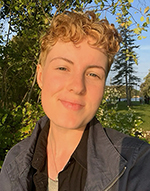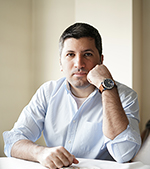 Volunteer Fernanda Solorza talks with the winter issue #225 contributor about beekeeping, story as ecosystem, and how distance brought clarity when writing their story, "Telling the Bees."
Volunteer Fernanda Solorza talks with the winter issue #225 contributor about beekeeping, story as ecosystem, and how distance brought clarity when writing their story, "Telling the Bees."
FS: How do you approach character development, especially in portraying the nuanced emotions of grief and guilt when facing challenges in the hive, and by extension, life? Can you discuss the significance of the narrator's evolving self-perception, particularly concerning their changing gender identity and the dynamics of their romantic relationship with Ellis?
KM:
The characters in this piece really came to me as I wrote, developing in response to the world. There is a symbiosis between their behaviours and their environment which made writing them fairly easy—they are exactly who they need to be. In this way, I think story functions as an ecosystem, with characters filling an ecological niche. It felt natural to me to have Ellis be the beekeeper and the caretaker—the love and willingness to learn that he has with the bees is the same love and willingness he shows in his relationship. The narrator, on the other hand, is more guarded, to protect themself and Ellis. At a base level, their response to the bees is the same as their response to the world—its misunderstandings, its potential threats. They are learning to be more comfortable in themself, in the way their relationship is perceived. It is Ellis who encourages them to become more open, to see things through a naturalistic, even hopeful lens. The nuance in these characters and their emotionality comes from the natural factors of their environment—the bees, the changing shape of their relationship, and the world’s response to it. Their grief and joy and love are all inherent to their situation.
Read the rest of Kaye Miller's interview as well as an excerpt.
Siavash Saadlou,
2023 CNF Prize winner
 Volunteer Jessica Rodríguez talks with the Constance Rooke CNF Prize winner about his memoir, "The Enemy" (featured in winter issue #225). They discuss writing about war, having an autobiographical memory, and why prose writers should read poetry.
Volunteer Jessica Rodríguez talks with the Constance Rooke CNF Prize winner about his memoir, "The Enemy" (featured in winter issue #225). They discuss writing about war, having an autobiographical memory, and why prose writers should read poetry.
JR: One of the things I enjoyed about your piece is that it captures the reader’s attention throughout. What type of research went into keeping this memoir true to the setting, facts, plot, and characters?
SS:
This particular piece didn’t require heavy research to be honest. It was all based on a heart-rending incident that had happened in real life during middle school, but I tried to contextualize it and draw the reader’s attention to a much larger theme: the never-ending repercussions of war. I guess you could say that having an autobiographical memory like mine is both a blessing and a curse. On the one hand, it allows you to write about your lived experience in excruciating detail; on the other hand, it torments you all your life in unexpected and inexplicable ways. That said, I’ve also been keeping in touch with friends from my school years, so I can always seek them out to confirm or correct certain recollections if need be. In terms of capturing the reader’s attention, what I’ve learned over time is that you don’t need to use overwrought prose to make your point. There’s a story in Sarah Manguso’s genre-bending book 300 Arguments in which she talks about attending, if memory serves, a poetry reading. While there, she is seated next to a young man who has a bit of a weather-beaten face. Eventually, Manguso decides to create some small talk with the young man and asks him about what it is that has brought him to the poetry reading. The young man simply responds, “I went to war.”
Read the rest of Siavash Saadlou's interview.
Janine Alyson Young, issue #225 fiction contributor
 Volunteer Hannah Eiserman talks with the winter issue #225 contributor about writing during the heaviest time of the pandemic, rejecting expectations of our roles and identities, and confronting our own biases when it comes to mental health and addiction in her story, "We Age and Age, but She's Vivid."
Volunteer Hannah Eiserman talks with the winter issue #225 contributor about writing during the heaviest time of the pandemic, rejecting expectations of our roles and identities, and confronting our own biases when it comes to mental health and addiction in her story, "We Age and Age, but She's Vivid."
HE: Since I’m always interested in process, I would love to start by asking where this story began for you? How did these characters, and their dynamic, emerge into being?
JAY:
I wrote an early draft of this story during the heaviest time of the pandemic, when people were isolated, and our awareness of each other’s suffering was collectively heightened and every vulnerability was accentuated. In BC the overdose rate was especially high. I was making extra effort to connect with my friends who lived alone and who had already been struggling with their mental health and addiction. A lot of the story is about that dangerous edge of ourselves, but it’s also about pleasure and recklessly ceasing what we want or need—through these characters I was interested in exploring the inner chaos that many of us were experiencing in those days.
Read the rest of Janine Alyson Young's interview as well as an excerpt.